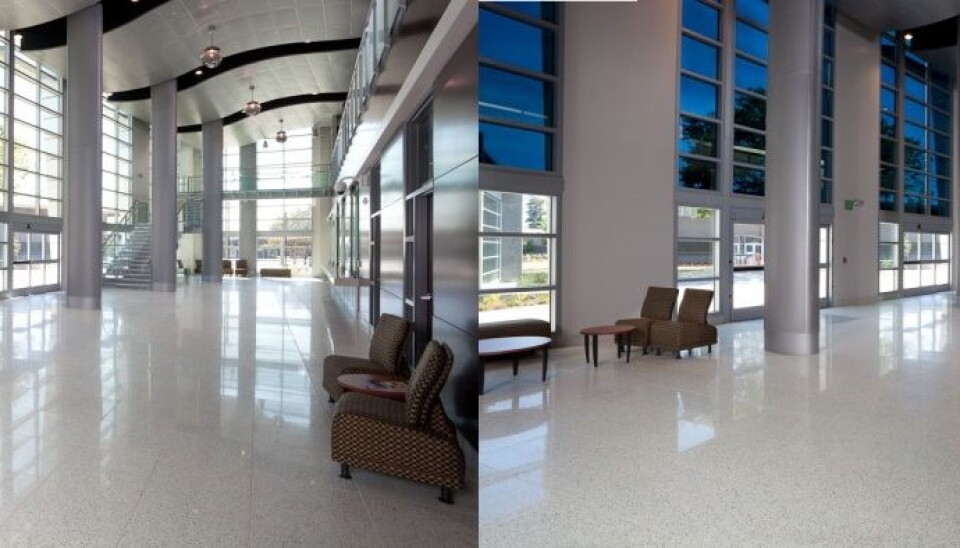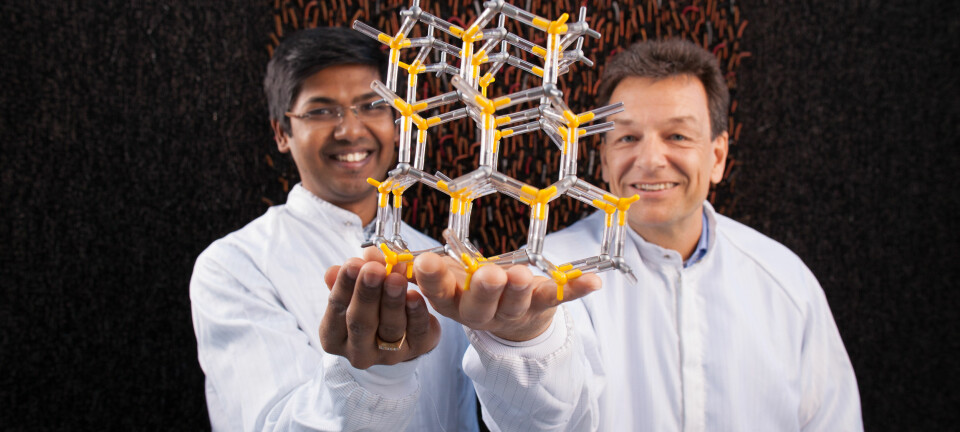An article from Norwegian SciTech News at SINTEF

Solar cells in the roof and nanotechnology in the walls
It isn't cars and vehicle traffic that produce the greatest volumes of climate gas emissions – it's our own homes. But new research will soon be putting an end to all that!
Denne artikkelen er over ti år gammel og kan inneholde utdatert informasjon.
The building sector is currently responsible for 40 percent of global energy use and climate gas emissions. This is an under-communicated fact in a world where vehicle traffic and exhaust emissions get far more attention.
In the future, however, we will start to see construction materials and high-tech systems integrated into building shells that are specifically designed to remedy this situation. Such systems will be intelligent and multifunctional. They will consume less energy and generate lower levels of harmful climate gas emissions.
With this objective in mind, researchers at Sintef are currently testing microscopic nanoparticles as insulation materials, applying voltages to window glass and facades as a means of saving energy, and developing solar cells that prevent the accumulation of snow and ice.
Giving industry a boost
Research Director Susie Jahren and Research Manager Petra Rüther are heading strategic efforts in the field of future construction materials. They say that although there are major commercial opportunities available in the development of green and low carbon building technologies, the construction industry is somewhat bound by tradition and unable to pay for research into future technology development.

“The strategic process allows us to position ourselves to assist in the industry’s development while at the same time also giving it a boost”, say Jahren and Rüther.
“Our researchers are working hard to produce innovative ideas about the directions future development might take. Then we check to see if the ideas they come up with are viable from a cost-benefit and environmental perspective”, they say.
Nanotechnology in the walls
Sintef researcher Bente Gilbu Tilset is sitting in her office in Oslo. She and her colleagues are looking into the manufacture of super-insulation materials made up of microscopic nanospheres.
“Our aim is to create a low thermal conductivity construction material “, says Tilset.
“When gas molecules collide, energy is transferred between them. If the pores in a given material are small enough, for example less than 100 nanometres in diameter, a molecule will collide more often with the pore walls than with other gas molecules. This will effectively reduce the thermal conductivity of the gas. So, the smaller the pores, the lower the conductivity of the gas”, she says.
While standard insulation materials such as mineral wools have conductivities in the region of 35 milliwatts per metre, nanospheres may exhibit values as low as about 20 mW/m. This is lower than the thermal conductivity of air. At present, these spheres are only available as a powder, but our dream is to aggregate them to form flexible mats.
In the future, nano-insulation materials such as these will enable us to reduce existing insulation material thicknesses. The mats will probably be more expensive than current products such as ‘Glava’, but will offer a better option in situations where space is at a premium such as in protected buildings where there are restrictions on making modifications to facades. They also work well as insulation materials for oil pipelines and industrial tanks.
Building-integrated solar cells
In the future, solar cells installed in panels fixed to our roofs and walls will be a thing of the past. Instead, they will be integrated into the roof tiles and external wall panelling materials. This will save on building materials and construction costs, and will reduce electricity bills.
In spite of Norway’s long, dark, winter nights, we are exposed to just as much daylight as Germany or the UK. A colder climate is in fact an advantage because solar cells are more effective in the cold.
“We reckon that this will become part of the Norwegian building tradition”, says physicist and researcher Tore Kolås.
As part of the project “Building Integrated Photovoltaics", researchers are planning to look into how we can utilise solar cells as integral housing construction components, and how they can be adapted to Norwegian daylight and climatic conditions.
One of the challenges is to develop a solar cell which prevents the accumulation of snow and ice. The cells must be robust enough to withstand harsh wind and weather conditions and have lifetimes that enable them to function as electricity generators.
“However, we will also be developing the construction materials so as to optimise their ability to adapt to Norwegian daylight conditions where the sun is low in the sky and solar radiation commonly diffuse”, says Kolås.
“Our aim, purely and simply, is to develop systems that are so effective that it will be natural for developers to consider them when evaluating building materials in the design phase.
Give and take
Today, we spend 90 percent of our time indoors. This is as much as three times more than in the 1950s. We are also letting less daylight into our buildings as a result of energy considerations and construction engineering requirements. Research shows that daylight is very important to our health, well-being and biological rhythms. It also promotes productivity and learning.
So the question is – is it possible to save energy and get the benefits of greater exposure to daylight?
Technologies involving thermochromic, photochromic and electrochromic pigments can help us to control how sunlight enters our buildings, all according to our requirements for daylight and warmth from the sun.
And with energy savings in mind, it may also be useful to employ materials that both absorb and release energy. So-called “phase-changing materials” offer this possibility.
For example, materials of this type can enable us to set the temperature of a room at 22 degrees. If the temperature falls below this level, the material will release heat into the room, or absorb it if the temperature rises above the stipulated level.
“Another possibility is the use of electrochromic coatings”, says researcher Bjørn Petter Jelle.
“This is a controllable technology made possible by applying an electrical voltage to a window. Users will be able to fix the level of solar radiation entering a building. This contrasts with adaptive technologies which adjust their function to ambient temperatures and other environmental factors. In the case of thermochromic windows, the glass changes colour according to the temperature, whereas photochromic windows change colour in response to changes in solar radiation intensity. Adaptive technologies enable us to decide the degree of adjustment as determined by temperature variation and the level of intensity of solar radiation."
Jelle says that electrochromic windows are already on the market. “They are frequently called ‘smart’ windows. Other non-traditional approaches used in windows as a means of exploiting external factors include the use of aerogel”, he says.
In the future, solar cells will be integrated into the roof tiles and external wall panelling materials. This will save on building materials and construction costs, and will reduce electricity bills.
----------------------
Read the Norwegian version of this article at forskning.no


































